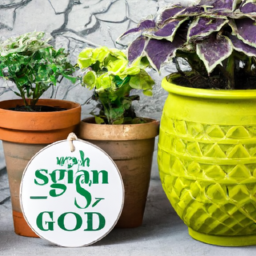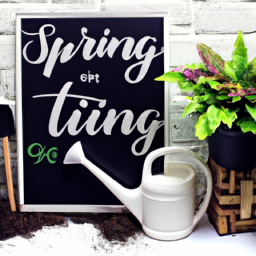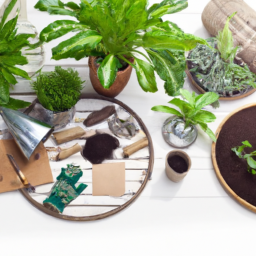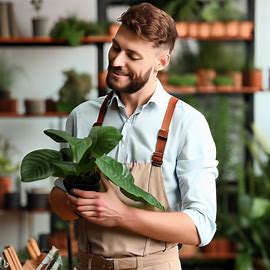
Are you a plant lover looking to bring the beauty of the outdoors inside? If so, you’re in luck! In this blog post, we will be delving into the exciting world of indoor gardening trends and exploring the latest innovations that are revolutionizing the way we cultivate plants within our homes. From vertical gardens to smart planters, there is a wide range of innovative solutions that are making indoor gardening more accessible and enjoyable than ever before. So, whether you’re a seasoned green thumb or just starting out, get ready to discover the cutting-edge techniques and trends that will help you create your own thriving indoor oasis.
Sustainable Indoor Gardening Techniques: Reducing Environmental Impact
Indoor gardening has gained immense popularity in recent years, with more and more people embracing the idea of bringing nature indoors. Not only does it enhance the aesthetic appeal of our living spaces, but it also offers numerous health benefits. However, as we strive to create green spaces within our homes, it is essential to consider the environmental impact of our indoor gardening practices. In this article, we will explore the latest innovations in sustainable indoor gardening techniques that can help reduce our ecological footprint.
1. Choosing Eco-Friendly Containers
The choice of containers for indoor plants can make a significant difference in reducing our environmental impact. Traditional plastic pots are not only non-biodegradable but also contribute to the growing plastic waste problem. Instead, opt for eco-friendly alternatives such as biodegradable pots made from materials like coconut coir, rice husks, or even recycled paper. These containers not only break down naturally over time but also provide essential nutrients to the plants as they decompose.
Another innovative option is the use of self-watering planters, which are designed to minimize water wastage. These containers feature a reservoir that holds excess water, allowing the plants to draw moisture as needed. This reduces the frequency of watering and prevents water runoff, ensuring efficient water usage and reducing the strain on our water resources.
Furthermore, consider repurposing everyday objects as plant containers. Mason jars, old teacups, or even unused wine bottles can add a unique touch to your indoor garden while reducing waste and promoting sustainability.
2. Embracing Hydroponics and Aquaponics
Hydroponics and aquaponics are innovative indoor gardening techniques that eliminate the need for soil, making them highly sustainable and efficient. Hydroponics involves growing plants in nutrient-rich water, while aquaponics combines hydroponics with fish farming. In aquaponics systems, the waste produced by the fish provides nutrients for the plants, creating a symbiotic relationship.
These techniques offer several advantages, including reduced water usage, faster plant growth, and higher yields. By eliminating the need for soil, hydroponics and aquaponics also minimize the risk of soil-borne diseases and pests, eliminating the need for harmful pesticides. Additionally, these systems can be set up vertically, maximizing space utilization and making them ideal for small indoor gardens.
Moreover, hydroponics and aquaponics allow for year-round gardening, irrespective of external weather conditions. This ensures a constant supply of fresh produce, reducing the carbon footprint associated with transportation and storage of imported fruits and vegetables.
3. Incorporating Energy-Efficient Lighting
Indoor plants require adequate lighting for photosynthesis, and choosing the right lighting system can significantly impact energy consumption. Traditional incandescent bulbs are highly inefficient and consume excessive electricity. Instead, opt for energy-efficient LED grow lights, which provide the necessary light spectrum for plant growth while consuming significantly less energy.
LED grow lights are available in various spectrums, allowing you to customize the lighting based on the specific needs of your plants. They also produce less heat, reducing the risk of plant damage and eliminating the need for additional cooling systems. By using energy-efficient lighting, you not only reduce your electricity bills but also contribute to a greener and more sustainable future.
In conclusion, sustainable indoor gardening techniques are essential for reducing our environmental impact while enjoying the benefits of indoor green spaces. By choosing eco-friendly containers, embracing hydroponics and aquaponics, and incorporating energy-efficient lighting, we can create thriving indoor gardens that are both visually appealing and eco-friendly. Let’s explore the latest innovations in indoor gardening and make a positive difference for our planet.

Indoor Gardening Trends: Exploring the Latest Innovations
2. Smart Indoor Gardening Systems: Embracing Technology for Efficient Plant Care
Indoor gardening has become increasingly popular in recent years, allowing plant enthusiasts to bring the beauty of nature into their homes. With advancements in technology, smart indoor gardening systems have emerged, revolutionizing the way we care for plants. These innovative systems combine automation, sensors, and connectivity to create an optimal environment for plants to thrive. In this article, we will explore the latest trends in smart indoor gardening systems and how they are transforming the way we nurture our indoor plants.
The Rise of Smart Indoor Gardening Systems
Smart indoor gardening systems have gained traction among gardening enthusiasts due to their ability to simplify plant care and ensure optimal growth conditions. These systems typically consist of a combination of smart sensors, automated watering systems, and connected mobile applications.
One of the key features of smart indoor gardening systems is their ability to monitor and adjust environmental conditions. Sensors embedded within the system can measure factors such as temperature, humidity, light intensity, and soil moisture. This data is then analyzed by the system, which can automatically adjust parameters such as watering schedules, lighting intensity, and even nutrient levels. This level of automation takes the guesswork out of plant care, making it easier for both beginners and experienced gardeners to achieve successful indoor gardens.
Another advantage of smart indoor gardening systems is their connectivity to mobile applications. These apps allow users to remotely monitor and control their indoor gardens, providing real-time data on plant health and growth progress. Notifications can be sent to alert users when it’s time to water or fertilize their plants, ensuring that they never miss a crucial care routine. Additionally, some apps even provide expert advice and plant-specific recommendations, making it easier for users to make informed decisions about their plant care.
The Benefits of Smart Indoor Gardening Systems
Smart indoor gardening systems offer several benefits that traditional gardening methods cannot match. One of the most significant advantages is their ability to optimize resource usage. By constantly monitoring environmental conditions, these systems can minimize water usage by only watering plants when necessary. This not only saves water but also prevents overwatering, a common cause of plant stress and disease.
Furthermore, smart indoor gardening systems can maximize energy efficiency by adjusting lighting schedules based on natural light availability. This not only reduces energy consumption but also ensures that plants receive the ideal amount of light for healthy growth. Some advanced systems even utilize LED lighting with customizable spectrums, allowing users to tailor the light spectrum to the specific needs of their plants.
Another benefit of smart indoor gardening systems is their ability to overcome space limitations. With vertical gardening solutions and compact designs, these systems enable individuals living in small apartments or urban areas to cultivate a wide variety of plants. By utilizing vertical space, these systems can accommodate a larger number of plants without occupying valuable floor space.
The Future of Smart Indoor Gardening Systems
The future of smart indoor gardening systems looks promising, with continuous advancements in technology and increasing demand for sustainable and convenient gardening solutions. As technology continues to evolve, we can expect even more sophisticated sensors, improved automation, and enhanced connectivity features.
One exciting area of development is the integration of artificial intelligence (AI) into smart indoor gardening systems. AI algorithms can analyze vast amounts of data collected from various sensors to optimize plant care routines. This includes predicting plant growth patterns, detecting early signs of diseases or nutrient deficiencies, and providing personalized recommendations for individual plants.
Another trend on the horizon is the integration of smart indoor gardening systems with smart home ecosystems. Imagine a future where your indoor garden seamlessly integrates with other smart devices in your home, such as voice-controlled assistants or automated window blinds. This level of integration would further streamline plant care and create a truly connected indoor gardening experience.
In conclusion, smart indoor gardening systems are revolutionizing the way we care for our indoor plants. By embracing technology, these systems provide an efficient and convenient solution for plant enthusiasts of all levels. With their ability to automate plant care routines, optimize resource usage, and overcome space limitations, smart indoor gardening systems are shaping the future of indoor gardening. So, why not embrace the latest innovations and embark on your own smart indoor gardening journey?

Vertical Indoor Gardening: Maximizing Space and Aesthetics with Green Walls
Indoor gardening has gained immense popularity in recent years, as more and more people are realizing the benefits of bringing nature into their homes. One of the latest trends in indoor gardening is vertical gardening, which not only maximizes space but also adds a unique aesthetic appeal to any indoor environment. In this article, we will explore the latest innovations in vertical indoor gardening and provide you with a step-by-step guide to get started.
Understanding Vertical Indoor Gardening
Vertical indoor gardening involves growing plants vertically, either on walls or specially designed structures, instead of the traditional horizontal garden beds. This innovative approach allows you to make the most of limited space, making it ideal for urban dwellers or those with small living areas. Additionally, vertical gardens serve as eye-catching focal points, adding a touch of greenery and beauty to any room.
To create a vertical garden, you will need to consider a few key elements. Firstly, you will need a suitable wall or structure that can support the weight of the plants and provide adequate drainage. It is important to choose a wall that receives sufficient natural light or invest in artificial lighting to ensure the plants thrive. Secondly, you will need to select the right plants for your vertical garden. Opt for plants that are well-suited to indoor environments and have a trailing or climbing growth habit, such as pothos, philodendron, or ivy.
Now, let’s move on to the step-by-step guide on how to create your own vertical indoor garden.
Step 1: Selecting the Right Wall or Structure
The first step in creating a vertical indoor garden is to choose a suitable wall or structure. Look for a wall that is sturdy and can handle the weight of the plants and the additional moisture. Consider using a waterproof membrane or a specially designed vertical garden system to protect the wall from water damage. Alternatively, you can opt for freestanding structures like trellises or plant stands that can be placed against a wall.
Ensure that the chosen wall or structure is located in an area that receives adequate natural light. If the area lacks natural light, you may need to invest in grow lights to provide the necessary light for plant growth.
Step 2: Preparing the Wall or Structure
Before you start installing your vertical garden, it is important to prepare the wall or structure properly. Clean the surface and repair any cracks or damages. Apply a waterproof sealant or membrane to protect the wall from moisture. If you are using a freestanding structure, ensure that it is stable and secure.
Next, create a suitable drainage system to prevent water accumulation. Install a waterproof liner or place a layer of plastic sheeting behind the vertical garden to protect the wall or structure. Add a layer of gravel or small rocks at the bottom to facilitate drainage.
Finally, consider adding a lightweight growing medium or potting soil to provide the plants with necessary nutrients. Make sure the medium is well-draining to prevent waterlogging.
Step 3: Choosing and Planting the Right Plants
Now comes the fun part – selecting and planting the right plants for your vertical garden. Choose plants that are well-suited for indoor environments and have a trailing or climbing growth habit. Some popular choices include pothos, philodendron, ivy, spider plants, and ferns.
When planting, ensure that the plants are properly spaced to allow for healthy growth. Consider using planters or pockets specifically designed for vertical gardens, which will help keep the plants securely in place. Place the plants at appropriate heights to create a visually appealing arrangement.
Remember to water your vertical garden regularly, as plants in vertical gardens may dry out more quickly than traditional gardens. Check the moisture levels frequently and adjust your watering schedule accordingly.
With these steps, you are well on your way to creating your own vertical indoor garden. Enjoy the beauty and benefits of a green wall right in your own home!
In Summary
Indoor gardening has become increasingly popular in recent years, with more and more people embracing the idea of bringing a touch of nature into their homes. And just like any other trend, indoor gardening is constantly evolving, with new innovations and ideas emerging all the time. In this blog post, we will explore some of the latest trends in indoor gardening and discover how these innovations are transforming the way we cultivate plants indoors.
One of the most exciting trends in indoor gardening is the rise of smart gardening systems. These innovative systems use technology to automate and simplify the process of growing plants indoors. From smart pots that monitor soil moisture levels and adjust watering accordingly to indoor gardens equipped with built-in LED lights that mimic natural sunlight, these systems make it easier than ever to maintain a thriving indoor garden. Additionally, many smart gardening systems can be controlled and monitored through smartphone apps, allowing you to keep an eye on your plants even when you’re not at home. With these advancements, anyone can now enjoy the benefits of indoor gardening, regardless of their previous experience or knowledge.
Top FAQs:
Q1: What are the latest trends in indoor gardening?
A1: Indoor gardening has seen some exciting trends in recent years. One popular trend is the use of vertical gardens, where plants are grown vertically on walls or specially designed structures. Another trend is the incorporation of smart technology, such as automated watering systems and plant sensors that monitor growth conditions. Additionally, people are increasingly turning to hydroponics, a soil-less method of growing plants using nutrient-rich water solutions. These innovative trends are revolutionizing the way we garden indoors.
Q2: How can I create a vertical garden in my indoor space?
A2: Creating a vertical garden is easier than you might think! Start by selecting a suitable wall or structure where you want to install your garden. Next, choose plants that are well-suited for vertical growth, such as trailing vines or compact herbs. Install a vertical gardening system, which typically consists of pockets or containers that hold the plants. Ensure proper irrigation by setting up a drip or misting system. Finally, regularly maintain your vertical garden by pruning and watering as needed. With a little effort, you can transform your indoor space into a stunning vertical oasis.
Q3: What are the benefits of incorporating smart technology in indoor gardening?
A3: Smart technology offers numerous benefits for indoor gardening enthusiasts. Automated watering systems take the guesswork out of plant care, ensuring that your plants receive the right amount of water at the right time. Plant sensors monitor factors like moisture levels, light intensity, and temperature, providing real-time data to help you optimize growing conditions. Some smart systems even offer smartphone apps, allowing you to control and monitor your garden remotely. By incorporating smart technology, you can maximize plant health and growth while minimizing the effort required for maintenance.
Q4: What is hydroponics, and why is it gaining popularity in indoor gardening?
A4: Hydroponics is a method of growing plants without soil, using nutrient-rich water solutions instead. This technique allows plants to absorb nutrients more efficiently, resulting in faster growth and higher yields. Hydroponics also conserves water, as it requires less water compared to traditional soil-based gardening. It is gaining popularity in indoor gardening due to its space-saving nature and the ability to grow a wide variety of plants in a controlled environment. Whether you have limited space or want to experiment with unique plant varieties, hydroponics offers an exciting and efficient way to garden indoors.
Q5: Are there any other innovative trends in indoor gardening worth exploring?
A5: Absolutely! In addition to vertical gardens and smart technology, there are other innovative trends worth exploring in indoor gardening. One such trend is the use of grow lights, which provide artificial light to supplement natural sunlight and promote plant growth. Another trend is the incorporation of living walls, where entire walls are covered with plants to create a stunning visual display. Additionally, urban gardening, which focuses on growing plants in small urban spaces, is gaining popularity as people seek to reconnect with nature in urban environments. These trends offer endless possibilities for creating unique and vibrant indoor gardens.

Alex Turner is a sustainable gardening advocate and the founder of an acclaimed indoor gardening blog. With a focus on eco-friendly practices and urban sustainability, Alex combines his background in environmental studies with his love for plants to educate readers on mindful indoor gardening. His work highlights the importance of nurturing both plants and the planet.


